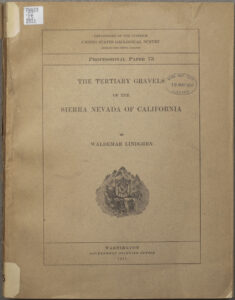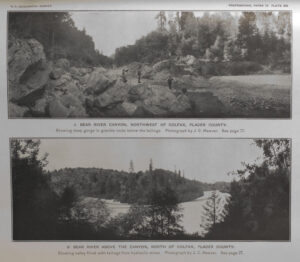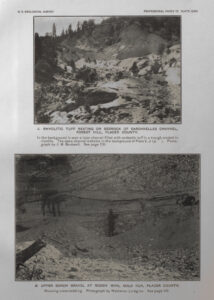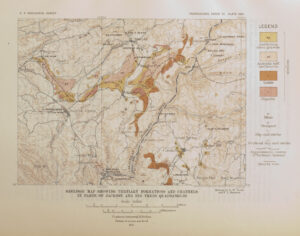Published: Washington D.C., 1911
The California Gold Rush occurred between 1848 and 1855, but gold mining continues in the state to this day. Placer mining was the initial extraction method, but it was replaced by hydraulic mining of Tertiary gravels in channels, especially in the central and northern Sierra Nevada. In hydraulic mining, high-pressure streams of water were blasted at gravel beds to separate gold from the gravel. The method produced a lot of gold, peaking in the 1870s. However, the debris damaged and polluted streams, which led to prohibitions. Drift mining and dredging followed.
Several members of the United States Geological Survey worked in the California gold district from 1886 to the early 1890s. One of them was Waldemar Lindgren, who wrote this summary work on the gold-bearing gravels in 1911. Tertiary Gravels is Professional Paper 73 of the U.S. Geological Survey.
 At the time of the paper’s publication, Lindgren had risen to the position of Chief Geologist after 30 years of service at the U.S. Geological Survey. A year later, he resigned to become the head of the Department of Geology at MIT. Lindgren had given a series of well-received lectures on ore deposits at MIT during the 1908-1911 academic terms. Emma Rogers, the widow of MIT’s founder, covered the expenses of much of the lectureship, as she was a strong supporter of the Department of Geology. After Lindgren joined the faculty, the MIT Corporation honored him with a special chair, the William Barton Rogers Professorship of Geology. He stayed at MIT for the next 21 years, serving as an administrator, prominent authority on mineral deposits, and esteemed teacher. The first edition of his classic work on the origin, classification, and
At the time of the paper’s publication, Lindgren had risen to the position of Chief Geologist after 30 years of service at the U.S. Geological Survey. A year later, he resigned to become the head of the Department of Geology at MIT. Lindgren had given a series of well-received lectures on ore deposits at MIT during the 1908-1911 academic terms. Emma Rogers, the widow of MIT’s founder, covered the expenses of much of the lectureship, as she was a strong supporter of the Department of Geology. After Lindgren joined the faculty, the MIT Corporation honored him with a special chair, the William Barton Rogers Professorship of Geology. He stayed at MIT for the next 21 years, serving as an administrator, prominent authority on mineral deposits, and esteemed teacher. The first edition of his classic work on the origin, classification, and  distribution of mineral deposits, Mineral Deposits, was published in 1913.
distribution of mineral deposits, Mineral Deposits, was published in 1913.
In The Tertiary Gravels of the Sierra Nevada of California, Lindgren sets out “an account of the Tertiary formations of that range and deals especially with the origin and distribution of the gold-bearing (auriferous) gravels which made these mountains one of the treasure houses of the world.” The paper specifically focuses on the Sierra Nevada north of 37 degrees, 30 minutes and from the Sacramento Valley to the eastern Great Basin.
The first part of the work describes the general topography, geology, and fossils of the Tertiary auriferous gravel district (including the “Calaveras Skull” hoax of 1866). This introductory section describes the nature and distribution of gold in the gravels, the methods of gold mining in California, and the production of gold by hydraulic, drifting, dredging, and surface mining for 1897-1909.
 The second part of the paper contains general geology and detailed descriptions of the Tertiary gravels and mineral deposits of 18 quadrangles from the Geologic Atlas of the United States, covering the central and northern Sierra Nevada. Particular attention is paid to the Colfax quadrangle, which had one of the richest masses of Tertiary gravels in the mountain range and yielded a great deal of gold. Detailed descriptions of the Placerville basin and Mokelumne Hill channel system are included in chapters on the Placerville and Jackson quadrangles.
The second part of the paper contains general geology and detailed descriptions of the Tertiary gravels and mineral deposits of 18 quadrangles from the Geologic Atlas of the United States, covering the central and northern Sierra Nevada. Particular attention is paid to the Colfax quadrangle, which had one of the richest masses of Tertiary gravels in the mountain range and yielded a great deal of gold. Detailed descriptions of the Placerville basin and Mokelumne Hill channel system are included in chapters on the Placerville and Jackson quadrangles.
The paper includes several photographs of the Sierra showing the gravels, areas that had hydraulic operations, and views of large areas. Several maps and sections are included in the text, along with an oversized compiled geologic map of the northern Sierra Nevada.
MIT holds two copies of the work: one as part of the U.S. Geological Survey Professional Paper series in the Hayden Library, and the other as part of the Libraries’ “Legacy Collection” of special materials.
